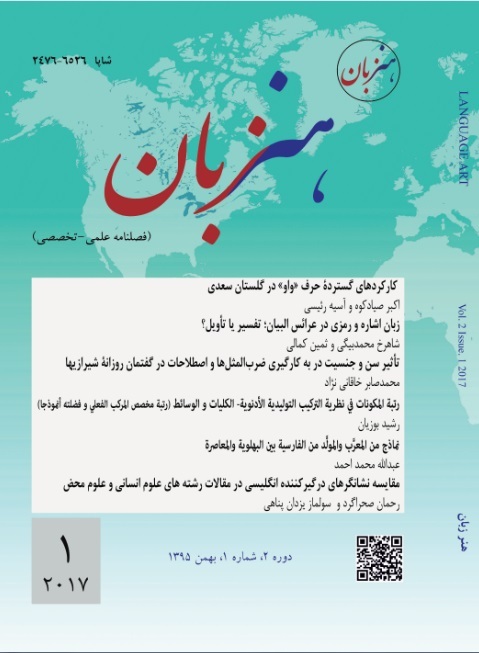مقایسه نشانگرهای درگیرکننده انگلیسی در مقالات رشته های علوم انسانی و علوم محض
DOI::
https://doi.org/10.22046/LA.2017.06کلمات کلیدی:
نشانگرهای درگیرکننده، علوم انسانی، علوم محض، مقاله.چکیده
نشانگرهای درگیر کننده از عناصر مهم زبان هستند که خواننده را درگیر تعامل با متن میکنند. علی رغم اهمیت آنها کار تخصصی زیادی جهت مقایسه آنها در متون علوم انسانی و علوم محض صورت نگرفته است. مطالعه حاضر تحلیلی کمی و کیفی از مقالات چهار رشته در علوم انسانی (روانشناسی، جامعه شناسی، اقتصاد، و حقوق) و چهار رشته در علوم محض (ریاضیات، زمین شناسی، فیزیک، و زیست شناسی) از نشانگرهای درگیر کننده در زبان انگلیسی ارایه میدهد. از هررشته 16 مقاله به طور تصادفی انتخاب شدند. درهمه ی قسمتهای مقالات نشانگرهای درگیر کننده جستجو و مشخص شدند. سپس آماری از آنها تهیه شد و مقایسه گردید. نتایج نشان داد که میزان استفاده از نشانگرها در علوم انسانی بطور معنا داری از علوم محض بیشتر است. همچنین مشخص شد که از سال 1990 تا 2000 استفاده از این نشانگرها در مقالات هر دوعلم افزایش یافته است.
مراجع
Ädel, A. (2006). Metadiscourse in L1 and L2 English. Amsterdam: John Benjamins.
Bakhtin, M. (1981). The dialogic imagination: four essays by M. M. Bakhtin. Translated by Emerson, C. and Holquist, M. Austin: University of Texas Press.
Bakhtin, M. (1986). Speech genres and other late essays. Austin, Texas: University of Texas Press.
Crismore, A. (1984). The case for a rhetorical perspective on learning from texts: Exploring metadiscourse. Champaign: Illinois University, Center for the Study of Reading.
Crismore, A. (1989). Talking with readers: metadiscourse as rhetorical act. New York: Peter Lang.
Dafouz-Milne, E. (2008). The pragmatic role of textual and interpersonal metadiscourse markers in the construction and attainment of persuasion: a cross-linguistic study of newspaper discourse. Journal of Pragmatics. 40(1): pp. 95-113.
Elbow, P. (1994). Landmark Essays on Voice and Writing. Davis, CA: Hermagoras Press.
Fuertes-Olivera., P., Velasco-Sacristán, M., Arribas-Baño., A., & Samaniego-Fernández, E. (2001). Persuasion and advertising English: metadiscourse in slogans and headlines. Journal of Pragmatics, 33(8): pp. 1291-1307.
Grabe, W., & Kaplan. R. (1996). Theory and practice of writing. Harlow: Longman.
Halliday, M. (1973). Explorations in the functions of language. London: Edward Arnold.
Harris, Z. (1959). Linguistic transformations for information retrieval. Structural and Transformational Linguistics, Dordrecht, pp. 458-471.
Hyland, K. (1998). Persuasion and context: the pragmatics of academic metadiscourse. Journal of Pragmatics, 30, pp. 437-455.
Hyland, K. (1999). Talking to students: Metadiscourse in introductory course books. English for Specific Purposes, 18(1): pp. 3–26.
Hyland, K. (2000). Disciplinary discourses: social interactions in academic writing. London: Longman.
Hyland, K. (2001). Bringing in the reader: addressee features in academic writing. Written Communication, 18(4): pp. 549-574.
Hyland, K. (2002a). Directives: argument and engagement in academic writing. Applied Linguistics, 23(3): pp.215-239.
Hyland, K. (2002b). What do they mean? Questions in academic writing. Text, 22(4): pp. 529-557.
Hyland, K. (2002c). Authority and invisibility: authorial identity in academic writing. Journal of Pragmatics, 34, pp. 1091-1112.
Hyland, K. (2004). A convincing argument: corpus analysis and academic persuasion. In Discourse in the professions. Perspectives from corpus linguistics, edited by U. Connor and T. A. Upton. Amsterdam: John Benjamins, pp. 87-112.
Hyland, K. (2005a). Metadiscourse: exploring interaction in writing. London: Continuum.
Hyland, K. (2005b). Stance and engagement: a model of interaction in academic discourse. Discourse Studies, 7(2): pp. 173-192.
Hyland, K. (2008). Applying a gloss: Exemplifying and reformulating in academic discourse. Applied Linguistics, 28(2): pp. 266-285.
Hyland, K., & Tse, P. (2004). Metadiscourse in academic writing: a reappraisal. Applied Linguistics, 25(2): pp. 156-177.
Johns, A. (1996). Text, Role and Context. Developing Academic Literacies. Cambridge: Cambridge University Press.
Kirsch, G., & Roen, D. (1990). A Sense of Audience in Written Communication. London and Newbury Park, CA: Sage.
Martin, J. & White, P. (2005). The language of evaluation: Appraisal in English. London/New York: Palgrave/Macmillan.
Myers, G. (1989). The Pragmatics of politeness in scientific articles. Applied Linguistics. 10.1: pp.1–35.
Nystrand, M. (1986). The structure of written communication: studies in reciprocity between writers and readers. Orlando, Florida: Academic Press.
Nystrand, M. (1999). A social-interactive model of writing. Written Communication, 6(1): pp. 66–85.
Preacher, K. (2001). Calculation for the Chi-square test: an interactive calculation tool for Chi-square tests of goodness of fit and independence [Computer software]. Retrieved from: http://quantpsy.org
Rommetveit, R. (1974). On message structure: a framework for the study of language and communication. London: Wiley.
Rommetveit, R. (1992). Outline of a dialogically based social-cognitive approach to humancognition and communication. In A. H. Wold (Ed.), The Dialogic Alternative: Towards a Theory of Language and Mind. Oslo: Scandanavian University Press.
Swales, J., Ahmad, U., Chang, Y., Chavez, D., Dressen, D., and Seymour, R. (1998). Consider this: the role of imperatives in scholarly writing. Applied Linguistics, 19(1): pp. 97-121.
Thetela, P. (1997). Evaluated Entities and Parameters of Value in Academic Research Articles. English for Specific Purposes 16(2): pp. 101-18.
Thompson, G. (2001). Interaction in academic writing: learning to agree with the reader. Applied Linguistics, 22(1): pp. 58–78.
Vande, K., & William J. (1985). Some Exploratory Discourse on Metadiscourse. College Composition and Communication, 36(1), pp.82-93.
Vande, K., & William, J. (1997). Refining and applying views of metadiscourse. Paper presented at the 48th Annual Meeting of the Conference on College Composition and Communication, Phoenix, Arizona, USA.
Widdowson, H. (1984). The description in scientific language. In H. G. Widdowson (Eds.), Explorations in Applied Linguistics. Oxford: Oxford University Press. pp. 57–61.
Williams, J. (1981). Style: ten lessons in clarity and grace (5th Ed.). Boston: Scott, Foresman.

